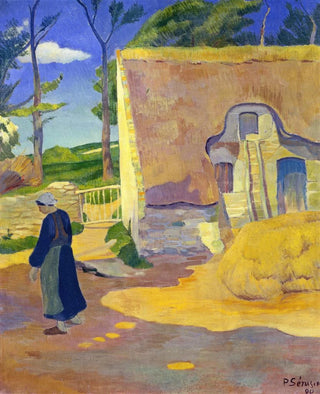Art print | Farm at Pouldu - Paul Sérusier


View from behind

Frame (optional)
Reproduction Ferme au Pouldu - Paul Sérusier – Captivating Introduction
The art print "Ferme au Pouldu" by Paul Sérusier is an iconic piece that transports us to the heart of Breton landscapes, imbued with a vibrant atmosphere and a bold color palette. Created in 1890, this work is part of the Post-Impressionist movement, marking a transition toward a more subjective approach to painting. Sérusier, as a member of the Nabis group, explores themes of nature and rural life here, while incorporating a personal vision that transcends mere representation. The art print Ferme au Pouldu - Paul Sérusier allows for a new perspective on this work, revealing the richness of its interpretation and its impact on modern art.
Style and uniqueness of the work
The style of "Ferme au Pouldu" is distinguished by its bold technique and innovative use of colors. Sérusier abandons realistic nuances in favor of pure, vibrant hues, creating an almost dreamlike atmosphere. The forms are simplified, the contours accentuated, giving the composition an unprecedented expressive strength. The farm, with its stone walls and tiled roof, becomes the focal point of a scene where the surrounding nature integrates harmoniously. The trees, fields, and sky are painted with a freedom that evokes a sense of movement and life. This work does not merely depict a place; it invites the viewer to feel the very essence of the Breton landscape, to immerse in a unique sensory experience.
The artist and his influence
Paul Sérusier, a major figure of the Nabi movement, managed to leave his mark on his era through an innovative approach to painting. A student of Gauguin, he was influenced by ideas of synthesis and simplification of forms. Sérusier played a key role in developing an aesthetic that prioritizes emotion and intuition over realistic representation. "Ferme au Pouldu" reflects this artistic quest, where each brushstroke seems charged with poetic intent. His influence extends beyond his time; it paved the way for many 20th-century artists who explored similar paths.

Matte finish

View from behind

Frame (optional)
Reproduction Ferme au Pouldu - Paul Sérusier – Captivating Introduction
The art print "Ferme au Pouldu" by Paul Sérusier is an iconic piece that transports us to the heart of Breton landscapes, imbued with a vibrant atmosphere and a bold color palette. Created in 1890, this work is part of the Post-Impressionist movement, marking a transition toward a more subjective approach to painting. Sérusier, as a member of the Nabis group, explores themes of nature and rural life here, while incorporating a personal vision that transcends mere representation. The art print Ferme au Pouldu - Paul Sérusier allows for a new perspective on this work, revealing the richness of its interpretation and its impact on modern art.
Style and uniqueness of the work
The style of "Ferme au Pouldu" is distinguished by its bold technique and innovative use of colors. Sérusier abandons realistic nuances in favor of pure, vibrant hues, creating an almost dreamlike atmosphere. The forms are simplified, the contours accentuated, giving the composition an unprecedented expressive strength. The farm, with its stone walls and tiled roof, becomes the focal point of a scene where the surrounding nature integrates harmoniously. The trees, fields, and sky are painted with a freedom that evokes a sense of movement and life. This work does not merely depict a place; it invites the viewer to feel the very essence of the Breton landscape, to immerse in a unique sensory experience.
The artist and his influence
Paul Sérusier, a major figure of the Nabi movement, managed to leave his mark on his era through an innovative approach to painting. A student of Gauguin, he was influenced by ideas of synthesis and simplification of forms. Sérusier played a key role in developing an aesthetic that prioritizes emotion and intuition over realistic representation. "Ferme au Pouldu" reflects this artistic quest, where each brushstroke seems charged with poetic intent. His influence extends beyond his time; it paved the way for many 20th-century artists who explored similar paths.






